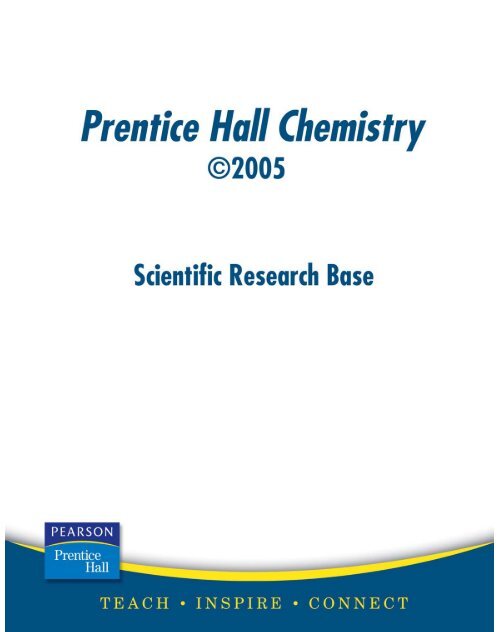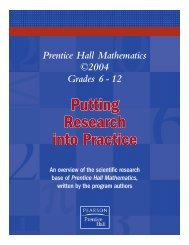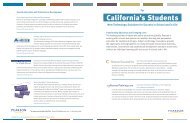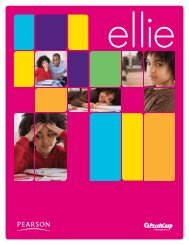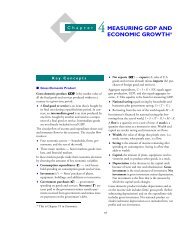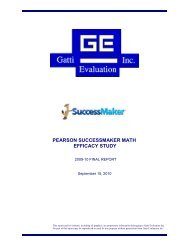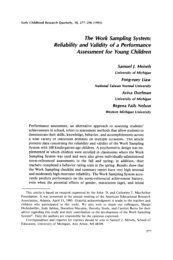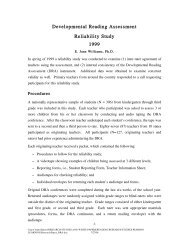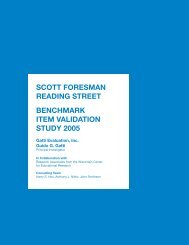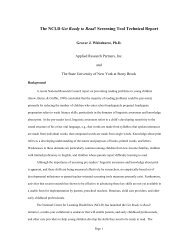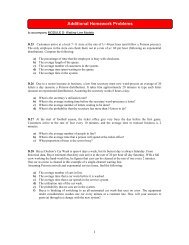Prentice Hall Chemistry. Pearson
Prentice Hall Chemistry. Pearson
Prentice Hall Chemistry. Pearson
- No tags were found...
You also want an ePaper? Increase the reach of your titles
YUMPU automatically turns print PDFs into web optimized ePapers that Google loves.
<strong>Prentice</strong> <strong>Hall</strong> <strong>Chemistry</strong>Research OverviewThe scientific research base used to develop <strong>Prentice</strong> <strong>Hall</strong> <strong>Chemistry</strong>describes how students learn science and provides classroom-basedevidence to validate program efficacy. This body of research alsoindicates key elements of a textbook program that ensure students’success: support for reading and mathematics in science, consistentopportunities for inquiry, and an ongoing assessment strand.In the following pages you will find summaries of the key concepts ofthe foundational research used to develop our program and specificreferences as to how this research was integrated into <strong>Prentice</strong> <strong>Hall</strong><strong>Chemistry</strong>.<strong>Pearson</strong> <strong>Prentice</strong> <strong>Hall</strong>’s research is conducted in phases and isongoing. The goal of establishing such rigorous research methods isto ensure that the program developed enables all students to learn the<strong>Chemistry</strong> skills and concepts they need for academic success and foreveryday life. The phases of our research include:(1) Exploratory Needs AssessmentAlong with periodic surveys concerning curriculum issues andchallenges, <strong>Pearson</strong> <strong>Prentice</strong> <strong>Hall</strong> conducts specific productdevelopment research, which includes discussions with teachersand advisory panels, focus groups, and quantitative surveys. Weexplore the specific needs of teachers, students, and othereducators regarding each component of the <strong>Prentice</strong> <strong>Hall</strong><strong>Chemistry</strong> program.(2) Formative, Prototype Development and Field TestingDuring this phase of research, we work to develop prototypematerials. We then test the materials, including field-testing withstudents and teachers, and qualitative and quantitative evaluationsof different kinds. We receive solid feedback about our lessonstructure in our early prototype testing. Results are channeled backinto the development of the program.(3) Summative, Validation ResearchFinally, <strong>Pearson</strong> <strong>Prentice</strong> <strong>Hall</strong> conducts longer-term research basedon scientific, experimental designs under actual classroomconditions. This research identifies what works and what can beimproved in the next revision of <strong>Prentice</strong> <strong>Hall</strong> <strong>Chemistry</strong>. <strong>Pearson</strong><strong>Prentice</strong> <strong>Hall</strong> also continues to monitor the program in the marketthrough ongoing dialogue with users. This allows us toperpetually refine our products and provide the best support totoday’s and tomorrow’s teachers and students.
In preparation for the NCLB mandates for science anticipated for 2007,<strong>Pearson</strong> <strong>Prentice</strong> <strong>Hall</strong> is committed to providing scientific research tosupport the efficacy of our science programs in the classroom.Our study designs will closely follow the criteria of No Child Left Behind.Since NCLB specifies a minimum level of improvement that students mustachieve each year, actual Adequate Yearly Progress (AYP) will be reflected inthe research used to validate the program.<strong>Prentice</strong> <strong>Hall</strong> <strong>Chemistry</strong>Scientific Research BasePage 2 of 10
Inquiry and <strong>Prentice</strong> <strong>Hall</strong> <strong>Chemistry</strong>What Research IndicatesThe National Science Education Content Standards define inquiry as theprocess in which students begin with a question, design an investigation,gather evidence, formulate an answer to the original question, andcommunicate the investigative process and results.The National Research Council in Inquiry and the National Science EducationStandards (2000), further identifies several “essential features” of classroominquiry, including the following:1. Who asks the question? That is, who asks the question that focuses theinvestigation (e.g., “What effect does the tilt of the earth have onseasons?” or “What effect does pH have on litmus paper?” or “Whichantacid best neutralizes acid?”)? Is it the student or the teacher/book?In most curricula, these are an element given in the materials. As aneducator you need to look for labs that, at least on a periodic basis,allow students to pursue their own questions.2. Who designs the procedures? We are speaking here of lab procedures orthe steps in an investigation. Who designs this process for gatheringinformation? In order to gain experience with the logic underlyingexperimentation, students need continuous practice with designingprocedures. Some labs, where the primary target is contentacquisition, designate procedures. But others should ask students todo so.3. Who decides what data to collect? This is similar to designingprocedures, but the focus is on the data itself. What data is importantand who determines that? Students need practice in determining thedata to collect.4. Who formulates explanations based upon the data? Do the text materialsgive the answers? Or do questions at the end of activities makestudents analyze and draw conclusions based on their data? Thebottom line—Do the questions make students think?5. Who communicates and justifies the results? Do activities push studentsto not only communicate but also justify their answers? Are activitiesthoughtfully designed and interesting so that students want to sharetheir results and argue about conclusions?Inquiry in <strong>Prentice</strong> <strong>Hall</strong> <strong>Chemistry</strong><strong>Prentice</strong> <strong>Hall</strong> <strong>Chemistry</strong> offers the most opportunities to get student to thinklike scientists and enables students to enhance their understanding byparticipating in the discovery.<strong>Prentice</strong> <strong>Hall</strong> <strong>Chemistry</strong>Scientific Research BasePage 3 of 10
<strong>Prentice</strong> <strong>Hall</strong> <strong>Chemistry</strong> encourages students to develop inquiry skills acrossthe spectrum from teacher-guided to open-ended. Flexible lab options areincluded in every chapter, structured from directed to open-ended –providing the flexibility to address all types of learners and accommodateyour class time and equipment requirements. Some focus on contentacquisition, and thus the question and most of the procedures are specified.<strong>Prentice</strong> <strong>Hall</strong> <strong>Chemistry</strong>Scientific Research BasePage 4 of 10
Assessment and <strong>Prentice</strong> <strong>Hall</strong> <strong>Chemistry</strong>The primary goal of NCLB is to provide classroom teachers with better datafro scientifically valid assessment in order to inform instructional planningand identify at-risk students who require intervention. It has been acommon practice to teach a science lesson, administer a test, grade it, andmove on. This practice is a thing of the past. With the spotlight now onimproving student performance, it is essential to use assessment results as away to identify student strengths and challenges. Providing studentfeedback and obtaining student input is a valuable, essential part of theassessment process.What Research IndicatesAn important assessment strategy is to ensure that students have ampleopportunities to check their understanding of skills and concepts beforemoving on to the next topic. Checking for understanding also includesasking appropriate, probing questions with each example presented. Thisenables students and teachers to know whether the skills or concepts beingintroduced are actually understood.Eileen DepkaSupervisor of Standards and AssessmentWaukesha, WisconsinIMPLEMENTASSESS<strong>Prentice</strong> <strong>Hall</strong> <strong>Chemistry</strong>Scientific Research BasePage 5 of 10
Assessment in <strong>Prentice</strong> <strong>Hall</strong> <strong>Chemistry</strong>The assessment strategies in <strong>Prentice</strong> <strong>Hall</strong> <strong>Chemistry</strong> will help both studentsand teachers alike ensure student success in content mastery as well as highstakestest performance. A wealth of opportunities built into the StudentEdition help students monitor their own progress. Teachers are supportedwith ongoing assessment opportunities in the Teacher’s Edition and an easyto-use,Examview“. These integrated, ongoing assessment tools assure success.Especially to support state and national testing objectives, <strong>Prentice</strong> <strong>Hall</strong> hasdeveloped test preparation materials that model the NCLB approach.In the Student Edition• Caption Questions: Enhance critical-thinking skills and maximize theeffectiveness of art, graphics, and narrative.• Checkpoint: Reinforce students’ understanding of the materialcovered.• Section Assessments: Questions that model the way students thinkand review ans assess the understanding the key concepts.• Comprehensive Study Guides and Chapter Assessments: Opportunitiesfor students to check their own understanding and practice valuablehigh-stakes test-taking skills.In the Program Resources• Examview“ Computer Test Bank CD-ROM: Provides teachers access tothousands of modifiable test questions, hundreds of which containalgorithmically-generated variable data.• Interactive Textbook with ChemASAP: In addition to electronicanimations and interactivities, the Interactive Textbook provides awealth of assessment tools. Students can monitor their progress atpoint of use with ongoing assessment, help tutorials, and instantfeedback.• Standardize Test Preparation Workbook: Includes topic-specific testprep items and practice tests that help teachers focus on improvingtest scores.<strong>Prentice</strong> <strong>Hall</strong> <strong>Chemistry</strong>Scientific Research BasePage 6 of 10
Reading Comprehension and <strong>Prentice</strong> <strong>Hall</strong> <strong>Chemistry</strong>What Research IndicatesModern understanding of comprehension emphasizes the importance of indepthprior knowledge and how that knowledge is organized. Studiescomparing novices and experts show that the conceptual organization ofexperts’ knowledge is very different from that of novices. For example,experts emphasize core concepts when organizing knowledge while novicesfocus on superficial details. To facilitate comprehension, effective teachingstrategies should support and scaffold students as they build anunderstanding of the key concepts and concept relationships within a textunit.Three complementary strategies are very important in facilitating studentcomprehension of science texts. First, guide student interaction with the textusing the built-in strategies. Second, organize the curriculum in terms of coreconcepts (e.g., Key Concepts in each Section). Third, develop visualrepresentations of the relationships among the key concepts and vocabularythat can be referred to during instruction.Dr. Nancy RomanceFlorida Atlantic UniversityReading in <strong>Prentice</strong> <strong>Hall</strong> <strong>Chemistry</strong>The concept of ‘considerate’ text has been built into the student editionthrough the careful design of text features that provide instructional supportfor comprehension. Each of these instructional features provides a strongliteracy framework for science teachers as they guide student interactionwith the text. Each, in turn, also serves as a scaffold for students as theybecome more independent learners.Before students read• The Guide for Reading introduces students to the key concepts andkey terms they’ll find in each section. The Reading Strategy isidentified.During the section• Boldface Sentences identify each key concept and encourage studentsto focus on the big ideas of science.• Reading Checkpoints reinforce students’ understanding by slowingthem down to review after every concept is discussed.• Caption Questions draw students into the art and photos, helpingthem connect the content to the images.After students read• Section Assessment questions allow students to review key concepts.<strong>Prentice</strong> <strong>Hall</strong> <strong>Chemistry</strong>Scientific Research BasePage 7 of 10
Math in the Science Classroom and <strong>Prentice</strong> <strong>Hall</strong> <strong>Chemistry</strong>What Research IndicatesWhy should students concern themselves with mathematics in thechemistry classroom? Good science requires good data from which to drawconclusions. Technology enhances the ability to measure in a variety ofways. Often scientists must measure large amounts of data, thus an aim ofanalysis is to reduce the data to a summary that makes sense and isconsistent with established norms of communication (e.g., mean, median, ormode), variability (e.g., range), and shape (graphic representations) caneffectively reduce 500 data points to 3 without losing the essentialcharacteristics of the data. Scientists understand that a trade-off existsbetween precision and richness as data is folded into categories, so marginsof error can be quantified in mathematics terms and factored into allscientific findings.Math Support in <strong>Prentice</strong> <strong>Hall</strong> <strong>Chemistry</strong>Recognizing the need for math support, <strong>Prentice</strong> <strong>Hall</strong> <strong>Chemistry</strong> integratesmathematics instruction throughout the program and gives students ampleopportunities to practice their math skills. The success of math instructionand practice in <strong>Prentice</strong> <strong>Hall</strong> <strong>Chemistry</strong> can be traced to nearly 20 years ofinteracting with chemistry teachers and students. Over the life of thischemistry program, <strong>Pearson</strong> <strong>Prentice</strong> <strong>Hall</strong> has developed strategies that allowstudents to see math a s a tools, not an impediment, in learning andunderstanding chemistry concepts.In the Student EditionSample Problems, CHEMath, Interpreting Graphs, and a Math Handbook allprovide the practice and instruction, which encourages students to read andunderstand, plan and solve, and then evaluate their answers.In the Teacher’s EditionMath support in the Teacher’s Edition is geared toward the math objectiveon high stakes tests. Teaching notes provide the chemistry teacher withstrategies for alternative instruction and additional practice. SampleProblems in the Student Edition are supported by additional PracticeProblems in the Teacher’s Edition.In the Guided Reading and Study WorkbookThese unique worksheets include Guided Practice Problems to help studentsmaster reading and enhance their study and math skills. Students can createa record of their work for study and review.<strong>Prentice</strong> <strong>Hall</strong> <strong>Chemistry</strong>Scientific Research BasePage 8 of 10
Differentiated Instruction and <strong>Prentice</strong> <strong>Hall</strong> <strong>Chemistry</strong>What Research IndicatesAll students are unique and their differences do not necessarily remainconstant. Their strengths and needs change as their literacy develops and asthey grow in their knowledge of science. Instruction that attempts to meetthe needs of all students must be flexible and adaptable for each individualand assessment of students’ strengths and needs must be continuous toensure that each student learns all they can.Instruction must be multi-sensory with learning opportunities that relyon all of the senses, and it must be scaffolded for each student’s learninglevel. Further, instruction with multi-media enhances the probability ofeach student’s learning.Differentiated Instruction in <strong>Prentice</strong> <strong>Hall</strong> <strong>Chemistry</strong>James FloodDiane LappSan Diego State UniversityIn the Student EditionThe considerate text structure offers amble reading support with elementsbefore, during and after each section of the lesson. Frequent use of analogiesis also part of a considerate text. The Guide for Reading helps studentsmaster concepts by introducing them to Key Concepts, Vocabulary, and aReading Strategy. Section Assessments allow student to review Key Conceptsat the end of every lesson. Additional differentiated strategies include:• Visual Learning: Graphs, charts, illustrations and photos work handin-handwith the text to clarify complex topics for those students whothink and learn visually.• Active Learning: Inquiry Activities, Quick Labs, and Small-Scale Labsprovide visual and tactile cues and offer opportunities for peercommunication as well as encourage sills that are necessary for criticalthinking. Internet connections through PHSchool.com and apartnership with NSTA bring timely, relevant, and appropriatechemistry topics to the classroom while engaging students with onlineinteractivities.In the Teacher’s EditionChapter Planning Guides label activities by levels of difficulty, meeting theneeds of all students. All program resources are identified by levels forConceptual, for Standard, and for Honors.The Teacher’s Edition includes Differentiated Instructional Support Ideas. Inorder to facilitate use, these practical ideas for visual learning, English<strong>Prentice</strong> <strong>Hall</strong> <strong>Chemistry</strong>Scientific Research BasePage 9 of 10
language learners, less proficient readers, advanced learners, andinclusion/special needs are placed at point-of-use areas throughout.For even more customize learning, the program resources include:• Guided Reading and Study Workbook: Instructional graphics providevisual reinforcement of complex topics.• Laboratory Manual and Small-Scale <strong>Chemistry</strong> Laboratory Manual:Lab options help teachers find the appropriate lab activities for everylearning style.• Interactive Textbook with ChemASAP: The Student Edition Onlineand on CD-ROM allows students to interact with content, includingreading aids, visual and interactive learning tolls, and instant feedbackassessment.<strong>Prentice</strong> <strong>Hall</strong> <strong>Chemistry</strong>Scientific Research BasePage 10 of 10


